Galactica Type Battlestar/jp:ギャラクティカ型バトルスター
More languages
More actions
This article discusses the Re-imagined Series battlestar class. For other meanings of Galactica, see Galactica (disambiguation).
|
The Galactica type battlestar[1] is a Colonial capital ship that combines the functions of aircraft carrier and a battleship [2].
| Galactica Type Battlestar/jp:ギャラクティカ型バトルスター | ||
|---|---|---|
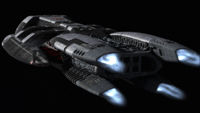
| ||
| 所属 | コロニアル | |
| 船種 | 軍用 | |
| FTL航行能力 | Yes (at least 2 drives[3]) | |
| 推進方法 | 6 sublight engines (4 in outboard engine pods, 2 on main hull between engine pods), 40 maneuvering engines (in 10 clusters of 4)[4] | |
| 搭乗員数 | 5000 | |
| 総搭載可能人数 | ||
| 船長/艦長名 | {{{co}}} | |
| 副長名 | {{{xo}}} | |
| 用途・目的 | Capital battleship/carrier | |
| 兵装 | Primary and point-defense Kinetic Energy Weapons, conventional missiles, nuclear warheads, Vipers, Raptors | |
| 武器リスト | {{{arm}}} | |
| 状態 | Last known ship destroyed | |
| 関連イメージ | イメージ | |
| 寸法 | ||
| 船体/機体長さ | 4719.95ft (1438.64m)[5] | |
| 船体/機体幅 | 1761.29ft (536.84m)[6] | |
| 船体/機体高さ | 601.43ft (183.32m) | |
| 重量 | {{{weight}}} | |
| 翼端長または全幅 | {{{wingspan}}} | |
| その他 | The dimensions above are from Lee Stringer, who built Galactica CG model. VFX Sequence Designer Adam "Mojo" Lebowitz gave the length as 4740 feet (1444.8m).[7] The reason for this twenty-foot discrepancy is unknown. | |
概要
edit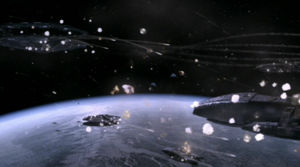
The first twelve battlestars were laid down in the early days of the Cylon War. Each of these twelve battlestars represented one of the Twelve Colonies of Kobol (TRS: "Miniseries").
The original battlestars were space-going leviathans of more than 4700 feet (1400 meters) in length, housing at least 4 squadrons of 20 Viper space superiority fighters apiece and nuclear warheads. A fully-armed battlestar is capable of a wide range of offensive actions, while her defensive armaments ensure she is fully capable of both protecting herself from attack and engaging an enemy at close quarters.
Following the end of the war, the original battlestars remained in service and many newer battlestars were built. At the time of the Fall of the Twelve Colonies, the newer Mercury class represented the top of the line. Ships such as these and the Valkyrie type battlestars have nearly completely replaced the original battlestars, making Galactica the last of this unnamed class still in its original condition. A few other ships of the class remained in service, although it is likely that these battlestars shared only their external configuration with Galactica, and were upgraded and thus more technologically advanced [8].
Layout
editThe design common to Galactica and her sister ships can be broken down into two main sections: the main hull, and the twin flight pods.
Main hull
editThis comprises the bulk of a battlestar and can itself be divided into three sections:
The "alligator head" contains water storage tanks (TRS: "Water") and the CIC.
The midships area contains the pod retraction mechanisms and crossways linking the hangar decks for the transfer of equipment and personnel (TRS: "Miniseries").
The stern section contains sublight engines, FTL drives, etc. Four of the sublight engines are in engine pods, and two more are between the pods.
Flight pods
edit- Main article: Flight pod
The flight pods are mounted on either side of the hull and contain a battlestar's Vipers and Raptors. During normal operations, they are extended away from the main hull. During FTL jumps, the pods are retracted against the hull, concealing their open ends and making launches and landings impossible, not including Viper launching; however, this would prevent the return of those Vipers. Each pod comprises two main decks for flight operations: the upper landing bay, which extends the full length of the pod, and the lower launch bays, which provide some 40 launch tubes per pod.
Landing approaches are made from the stern. The preferred approach is a slow run into the landing bay, prior to making a vertical landing on a defined landing area (TRS: "Act of Contrition"). However, in emergencies, combat landings can be made, in which a craft approaches and lands at high speed on its landing skids (TRS: "Miniseries").
The hangar deck is used for maintenance, repair, refueling, rearming, and launch operations and runs the length of the flight pod.
仕様
edit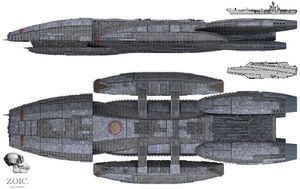
推進
edit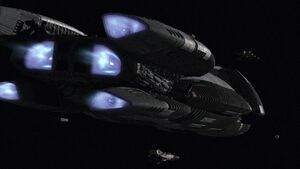
- Main article: Propulsion in the Re-imagined Series
Despite their massive size, battlestars are extremely maneuverable and can dock with space stations such as Ragnar Anchorage. Battlestars are not designed for atmospheric flight, although their hulls can manage a tenuous upper atmospheric storm like that surrounding the gas giant Ragnar (TRS: "Miniseries") and can survive a jump and subsequent freefall into the atmosphere of a habitable planet (TRS: "Exodus, Part II"). A battlestar's FTL systems are capable of accurate jumps, able to place them in synchronous orbit above a relatively close planet and of placing them safely in the midst of an asteroid field (TRS: "The Hand of God"), a dense fleet of ships (TRS: "Scattered"), or a planetary atmosphere. However, they are grossly inferior to Cylon systems in terms of safe range (TRS: "Kobol's Last Gleaming, Part I").
Endurance
editBattlestars are intended to operate for long periods without re-supplying. Their water purification capabilities alone are so efficient that, barring an emergency or unforeseen event, a battlestar can operate "for several years before replenishing" (TRS: "Water"). They also appear capable of undertaking large-scale repairs following battle damage (TRS: Miniseries, "Water"). They have ammunition assembly capabilities in the armory (TRS: "Epiphanies") and may have small general fabrication facilities (TRS: "Litmus"). Vegetable stores and canned goods are kept in titanium lockers (TRS: "Final Cut"). Battlestars are capable of continuing combat operations despite suffering massive damage, as evidenced by Galactica's continuing effectiveness at defending the fleet years after the first Cylon attack and following several punishing engagements (TRS: "He That Believeth in Me").
コンピューター・システム
edit- Main article: Computers in the Re-imagined Series
The original battlestar vessels deliberately avoided the use of networked primary computer systems during the Cylon War, as Cylon forces were adept at infiltrating and subverting such systems (TRS: "Miniseries").
On Galactica, in the post-Cylon War era, these primary computers remained isolated by practice on order of its last pre-Holocaust commanding officer, William Adama. This no-networks practice saved Galactica from the fate of its sister battlestars in the Fall of the Twelve Colonies as Galactica's no-network order meant that the CNP, installed in almost all Colonial Fleet vessels at the time, could not be used aboard Galactica as the CNP was designed for use with a computer network.
In one dire instance in the early months of their exodus, Galactica networks its primary computers temporarily to aid in computation speeds for jump calculations needed to find the missing civilian Fleet (TRS: "Scattered"), but it is not without consequence. One or more computers are cracked during a Cylon attack with a Cylon virus, which proves resistant to removal and (weeks later) threatens the operation of the battlestar until the computers' hard drives are erased and restored from pre-Fall backup sets (TRS: "Flight of the Phoenix").
武装
edit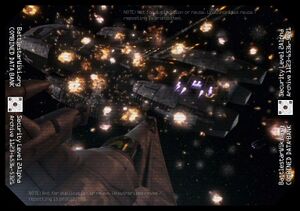
- Main article: Weapons in the Re-imagined Series
- 24 large antiship gun turrets (mounting 2 guns apiece) [9]
- These are mounted on the dorsal and ventral surfaces of the main hull and the ventral surface of the bow. The two guns on each turret fire in tandem. They have been shown to be quite effective against targets like basestars (TRS: "Resurrection Ship, Part II"). These large guns are able to use both flak ammunition and high-explosive anti-capital ship shells. Additionally, the guns are able to engage in coordinated barrage strategies, such as salvo (and presumably, volley) fire.
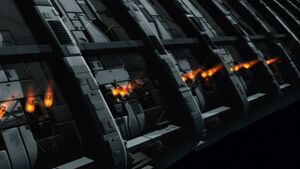
- 514 smaller point-defense turrets (mounting 2 guns apiece) [10]
- These are mounted on the flight pods and other surfaces. Each barrel fires explosive rounds in bursts.
- Multiple nuclear warheads [11]
- Deployed from 12 launch tubes mounted in the main hull (TRS: "The Eye of Jupiter").
- Even the latest Mk. VII Vipers remain compatible with this class's launch and recovery facilities.
乗員
editGalactica's crew complement prior to her scheduled decommissioning was approximately 2,800 [14]. This figure is almost certainly higher for a fully staffed, operational battlestar.
生命維持
editApproximately twelve oxygen recirculation units are mounted throughout the ship, which replenish oxygen as well as remove ("scrub") carbon dioxide from the air. These devices work continuously (TRS: "Final Cut").
Known Galactica type battlestars
edit- Named:
- Unnamed:
- See: Unnamed battlestars
See also
edit- Blue prints from Battlestar Galactica from the RPG
- Note: These are not considered canonical.
注釈
edit- ↑ This is a Battlestar Wiki descriptive term.
- ↑ Although not strictly official and not yet shown or confirmed in the series itself, the September 2006 Maxim issue contained a photoshoot, including this picture showing the weapons control room in the CIC. A printout on the table reads "Galactica class battlestar".
- ↑ Tigh: "Engineering/Combat. Please spin up FTL drives One and Two." (TRS: "Miniseries")
- ↑ Originally sourced to Zoic without explanation.
- ↑ These dimensions (in meters) were derived from the CG model and posted by Lee Stringer on the StarshipBuilder.com forums, which are no longer available. They are the most precise so far. The width with pods extended and the height are quoted here verbatim; the length was calculated by adding the posted dimension for the front of the ship (766.04m) to the posted dimension for the back (672.6m). The full set as provided by Lee Stringer is as follows: "Width (Pods out) 536.84m (Pods In) 352.34m Engines Max 359.38m Head Max 334.58m Length: Front (Main body) 730.65m (Antenee) 766.04m Back 672.6m (using the center of the two arms as the middle) Height (Armor/Mainbody) 181.825m (Details) 183.315m".
- ↑ This is from flight pod to flight pod while they are extended.
- ↑ Blog comment by Adam "Mojo" Lebowitz.
- ↑ Aaron Doral's comment at the start of the Miniseries, that Galactica is the "last of her kind," suggests that other Galactica type battlestars still in service use equipment that may be entirely different, regardless of the external configuration. Doral could also be referring to the lack of computer networks on Galactica as opposed to the rest of the fleet, which still indicates hardware upgrades during the vessels' lifetimes.
- ↑ These are rail guns (Battlestar Galactica RPG) 1 and 2 mark the position of these guns, with 8 on the dorsal and 16 on the ventral hull (of which 8 are mounted on the bow). Note that 2 turrets on either side of the bow are partially obscured and not marked in image 1.
- ↑ Number of the guns on the CGI model by Zoic, does not account for dorsally mounted and ventrally mounted guns
- ↑ As of the episode "Bastille Day," Galactica was equipped with five nuclear warheads. This may be lower than the typical number, since Galactica was in the process of being decommissioned and had already had most of its ammunition removed. If this is the case, we must conclude that Galactica was unable to reload its supply of nuclear arms at Ragnar Anchorage (a sensible proposition, given the ease with which purported arms smuggler Leoben Conoy was able to gain access to the facility).
- ↑ After the destruction of 20 Vipers during the Cylon attack, Galactica was still able to muster a 40-Viper strong defensive screen by combining their remaining squadron of Mk. VII Vipers with a full squadron of Mk. II Vipers from a museum exhibit in the starboard flight pod. This suggests that Galactica, with a single operational flight pod, was fielding two squadrons from it, and that when fully operational it could have fielded an additional two squadrons from the starboard pod.
- ↑ At the time of the Cylon attack, Galactica was apparently equipped with at least eight.
- ↑ According to a crew tally, Galactica is staffed by approximately 2,700 people at the time of its decommissioning. The full crew complement would be higher as has been indicated as roughly twice as high by some sources.
